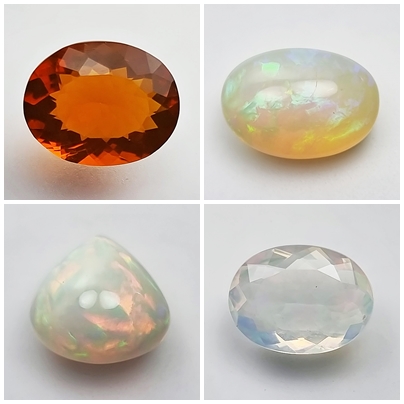Opal: Gemstone Information
Opal Gemstone: Beauty, Metaphysical Properties, and Benefits
Opal, renowned for its stunning play-of-color, is a gemstone cherished for its unique beauty and metaphysical properties. This article explores the characteristics, metaphysical properties, and benefits associated with opal.
Characteristics:
Opal is a hydrated amorphous form of silica, chemically composed of silicon dioxide (SiO2) and water (H2O). Its play-of-color, a mesmerizing display of spectral hues, arises from the diffraction of light by microscopic silica spheres arranged in a regular pattern within the opal matrix. The colors can range from fiery reds and oranges to vibrant blues and greens, depending on the arrangement and size of the silica spheres. Opal’s base color varies widely, from colorless to white, black, or other hues, adding to its allure.
Metaphysical Properties:
Opal has long been revered for its metaphysical properties and associations with spiritual growth, emotional healing, and personal transformation. Here are some metaphysical properties commonly attributed to opal
Creativity and Inspiration: Opal is believed to stimulate creativity and inspire originality. It encourages imaginative thinking and helps individuals express themselves artistically in various endeavors, from art and writing to problem-solving and innovation.
Emotional Healing: Opal is thought to have a soothing and calming energy that promotes emotional healing and inner peace. It can help alleviate stress, anxiety, and emotional burdens, allowing individuals to release negative emotions and embrace positivity and joy.
Spiritual Awakening: Opal is associated with spiritual awakening and enlightenment. It enhances intuition and spiritual awareness, facilitating deeper connections with the self and the spiritual realms. Opal encourages spiritual growth and guides individuals on their spiritual journey towards higher consciousness.
Protection: Opal is believed to possess protective energies that shield individuals from negative influences and psychic attacks. It creates a protective shield around the aura, guarding against harmful energies and promoting a sense of security and well-being.
Harmony and Balance: Opal is thought to bring harmony and balance to all aspects of life, including relationships, emotions, and energies. It promotes harmony within oneself and fosters harmonious relationships with others, creating a sense of unity and interconnectedness.
Manifestation: Opal is associated with manifestation and abundance. It helps individuals manifest their desires and attract prosperity, success, and abundance into their lives. By aligning with the energies of abundance, opal supports the manifestation of dreams and goals.
Benefits:
Opal offers a range of benefits beyond its metaphysical properties, making it a cherished gemstone for both spiritual and practical purposes:
Aesthetic Beauty: Opal’s captivating play-of-color and diverse color variations make it a popular choice for jewelry and ornamental purposes. Whether set in rings, necklaces, earrings, or bracelets, opal’s radiant beauty adds a touch of elegance and sophistication to any ensemble.
Healing Properties: Opal is believed to possess healing properties that benefit the mind, body, and spirit. It can support physical healing processes, alleviate ailments, and promote overall well-being. Opal’s calming energy can also help reduce stress, improve sleep quality, and enhance relaxation.
Spiritual Growth: Opal facilitates spiritual growth and personal transformation by enhancing intuition, expanding consciousness, and fostering inner wisdom. It encourages individuals to explore their spiritual path, connect with their higher self, and align with their life’s purpose.
Emotional Support: Opal provides emotional support by promoting emotional healing, balance, and resilience. It helps individuals release past traumas, overcome emotional challenges, and cultivate a positive mindset. Opal’s uplifting energy can bring joy, happiness, and emotional fulfillment.
Relationship Harmony: Opal is associated with love, passion, and harmony in relationships. It can deepen emotional bonds, enhance communication, and foster mutual understanding between partners. Opal’s nurturing energy promotes love, compassion, and empathy, creating a harmonious and fulfilling relationship dynamic.
Inspiration and Creativity: Opal stimulates creativity, imagination, and innovation, making it an ideal gemstone for artists, writers, and creative individuals. It encourages originality, spontaneity, and out-of-the-box thinking, inspiring new ideas and creative expressions.
Conclusion:
Opal’s beauty, metaphysical properties, and benefits make it a highly valued gemstone cherished by individuals seeking spiritual growth, emotional healing, and personal transformation. Whether worn as jewelry or used for metaphysical purposes, opal’s radiant energy and transformative qualities continue to captivate hearts and minds around the world.
Buy Our Natural Opal Gemstones Online at http://Gemfame.com Call for details at Mobile +91 9444456511, Landline +91 44 42333655.





